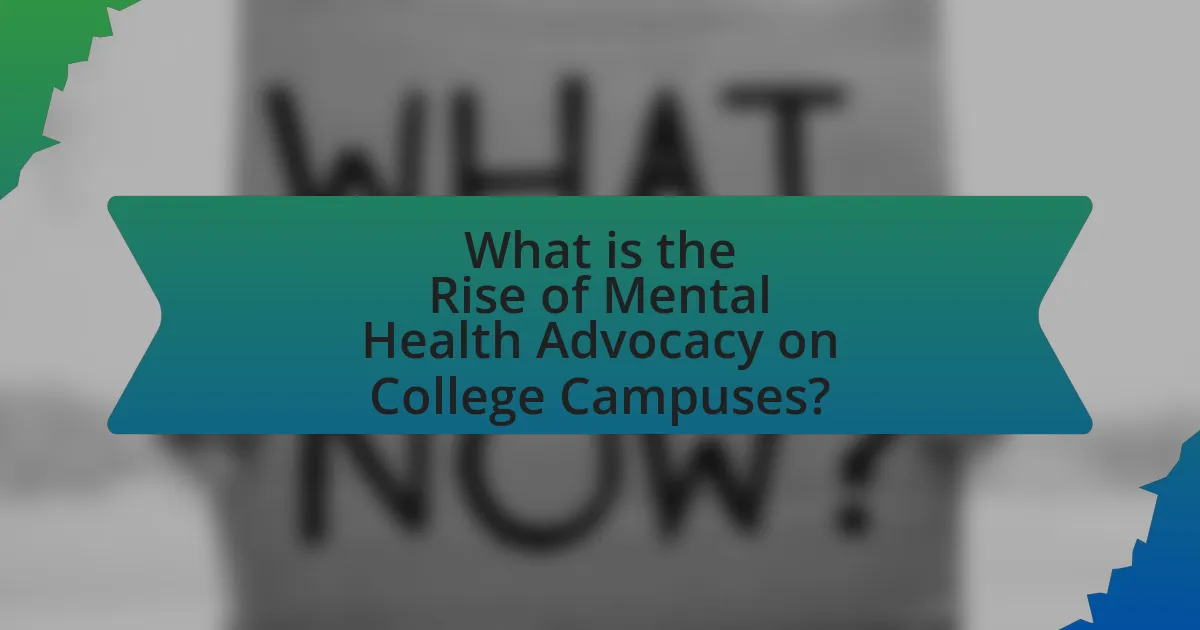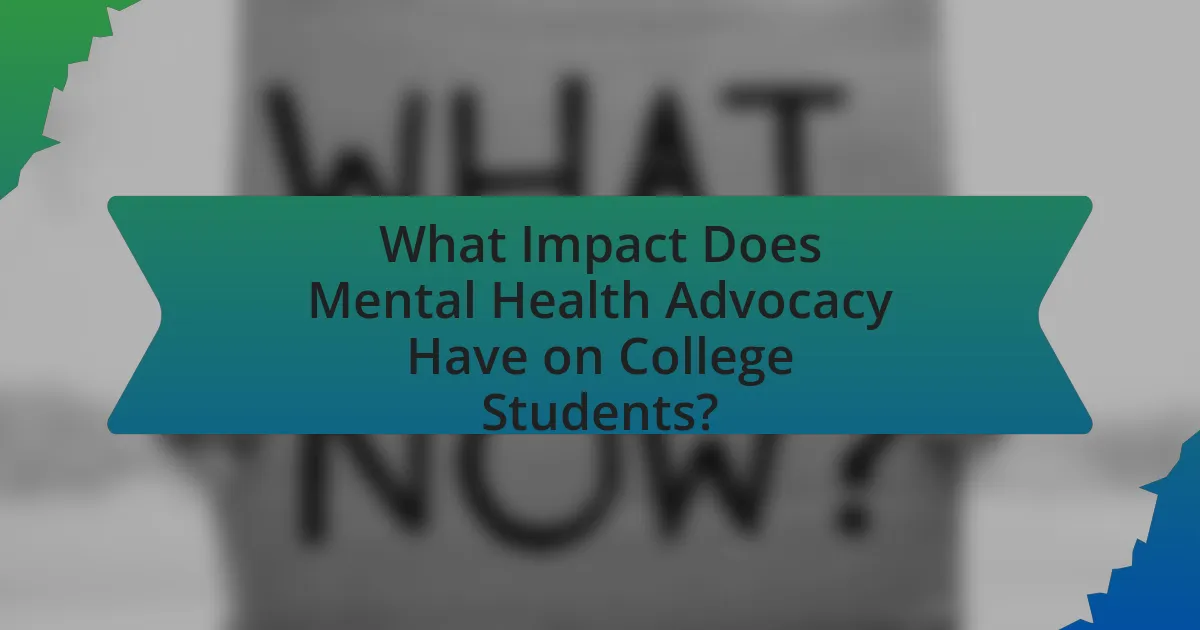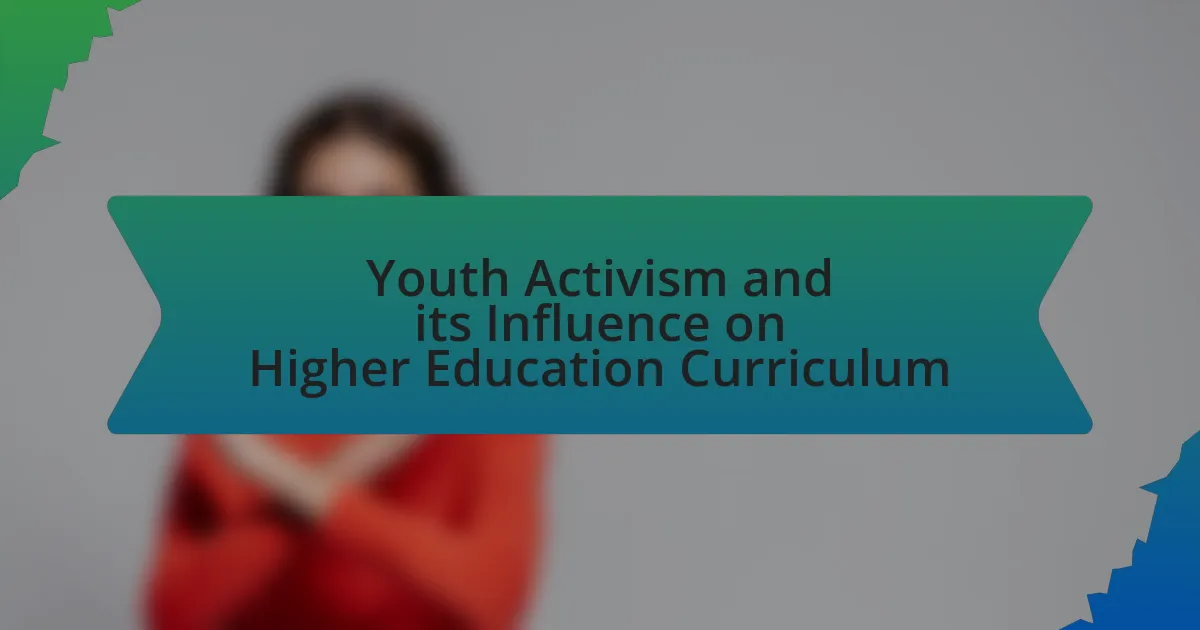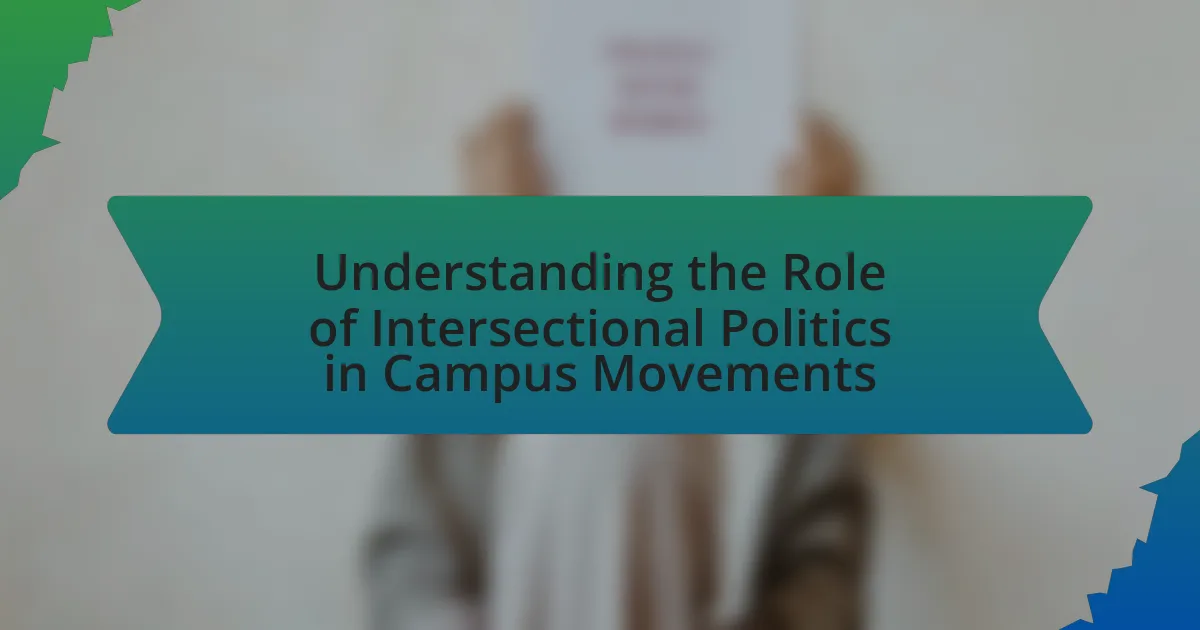The rise of mental health advocacy on college campuses highlights the increasing efforts by students, faculty, and administration to promote mental health awareness and support services. With nearly 1 in 5 students experiencing mental health challenges, initiatives such as peer support programs, awareness campaigns, and counseling resources have become essential in reducing stigma and improving access to care. The article explores the factors contributing to this movement, the key components of effective advocacy, the role of student organizations, and the impact of societal changes on mental health initiatives. Additionally, it addresses the challenges colleges face in promoting mental health advocacy and the long-term benefits of these efforts for student well-being and academic success.

What is the Rise of Mental Health Advocacy on College Campuses?
The rise of mental health advocacy on college campuses refers to the increasing efforts by students, faculty, and administration to promote mental health awareness and support services. This movement has gained momentum due to the growing recognition of mental health issues among college students, with studies indicating that nearly 1 in 5 students experience mental health challenges during their academic careers. Advocacy initiatives often include peer support programs, mental health awareness campaigns, and the establishment of counseling resources, which aim to reduce stigma and improve access to care. The National Alliance on Mental Illness (NAMI) reports that campuses with active mental health advocacy see higher engagement in mental health services, demonstrating the effectiveness of these efforts in fostering a supportive environment for students.
Why has mental health advocacy become a priority in higher education?
Mental health advocacy has become a priority in higher education due to the increasing prevalence of mental health issues among students. Research indicates that approximately 1 in 5 college students experience mental health challenges, such as anxiety and depression, which can significantly impact their academic performance and overall well-being. The growing recognition of these issues has prompted institutions to implement support systems, such as counseling services and awareness programs, to foster a healthier campus environment. Additionally, the stigma surrounding mental health has decreased, encouraging more students to seek help and engage in advocacy efforts.
What factors have contributed to the increased focus on mental health in colleges?
The increased focus on mental health in colleges is primarily driven by rising awareness of mental health issues among students, increased prevalence of mental health disorders, and the impact of social media. Awareness campaigns and advocacy efforts have highlighted the importance of mental well-being, leading to greater acceptance and understanding of mental health challenges. Statistics indicate that approximately 1 in 5 college students experience a mental health condition, underscoring the need for accessible support services. Additionally, social media has amplified discussions around mental health, creating a culture where students feel more comfortable seeking help and sharing their experiences.
How do societal changes influence mental health advocacy on campuses?
Societal changes significantly influence mental health advocacy on campuses by increasing awareness and reducing stigma surrounding mental health issues. As societal attitudes shift towards greater acceptance of mental health discussions, universities respond by implementing more comprehensive mental health programs and resources. For instance, the National Alliance on Mental Illness reports that 1 in 5 college students experience mental health issues, prompting institutions to prioritize mental health services. Additionally, movements such as #MeToo and Black Lives Matter have highlighted the importance of mental well-being in marginalized communities, leading campuses to adopt more inclusive and supportive mental health initiatives. These societal changes create an environment where mental health advocacy can thrive, resulting in increased funding, awareness campaigns, and peer support networks on college campuses.
What are the key components of mental health advocacy in colleges?
The key components of mental health advocacy in colleges include awareness, accessibility, and support systems. Awareness involves educating students and staff about mental health issues, reducing stigma, and promoting open discussions. Accessibility refers to providing resources such as counseling services, mental health hotlines, and workshops that are easily reachable for students. Support systems encompass peer support groups, training for faculty to recognize mental health issues, and creating a campus culture that prioritizes mental well-being. These components are essential for fostering an environment where students feel safe to seek help and engage in mental health conversations.
What programs and initiatives are commonly implemented for mental health support?
Commonly implemented programs and initiatives for mental health support include peer counseling, mental health awareness campaigns, and access to professional counseling services. Peer counseling programs, such as those offered by universities, allow students to receive support from trained peers who understand their experiences. Mental health awareness campaigns, often organized during Mental Health Awareness Month, aim to reduce stigma and promote resources available on campus. Additionally, universities typically provide access to professional counseling services, which may include individual therapy, group therapy, and workshops focused on stress management and coping strategies. These initiatives are supported by research indicating that peer support and professional counseling significantly improve mental health outcomes among college students.
How do peer support networks contribute to mental health advocacy?
Peer support networks significantly enhance mental health advocacy by providing individuals with shared experiences and emotional support, which fosters a sense of belonging and reduces stigma. These networks empower students to openly discuss mental health issues, thereby increasing awareness and understanding within the campus community. Research indicates that peer support can lead to improved mental health outcomes, as evidenced by a study published in the Journal of American College Health, which found that students engaged in peer support programs reported lower levels of anxiety and depression. This collective effort not only promotes individual well-being but also drives systemic changes in mental health policies and resources on college campuses.
What challenges do colleges face in promoting mental health advocacy?
Colleges face significant challenges in promoting mental health advocacy, primarily due to stigma, resource limitations, and varying levels of awareness among students and staff. Stigma surrounding mental health issues often prevents individuals from seeking help, as many fear judgment or discrimination. Additionally, many colleges struggle with inadequate funding and staffing for mental health services, which limits their ability to provide comprehensive support. Furthermore, there is often a lack of consistent training for faculty and staff on mental health issues, leading to varying degrees of understanding and support for students in need. These factors collectively hinder effective mental health advocacy on college campuses.
How do stigma and misconceptions affect mental health initiatives?
Stigma and misconceptions significantly hinder mental health initiatives by creating barriers to access and participation. When individuals perceive mental health issues as a sign of weakness or fear judgment, they are less likely to seek help or engage in programs designed to support mental well-being. Research indicates that approximately 60% of college students with mental health concerns do not seek help due to stigma (Eisenberg et al., 2009, Journal of American College Health). This reluctance undermines the effectiveness of mental health initiatives, as lower participation rates can lead to insufficient funding and resources, ultimately perpetuating the cycle of misunderstanding and neglect surrounding mental health on campuses.
What barriers exist in accessing mental health resources on campuses?
Barriers to accessing mental health resources on campuses include stigma, limited availability of services, and inadequate funding. Stigma surrounding mental health often prevents students from seeking help due to fear of judgment or discrimination. Additionally, many campuses face a shortage of mental health professionals, leading to long wait times for appointments and insufficient support for the student population. According to a report by the American College Health Association, 63% of college students felt overwhelmed by anxiety, yet only a fraction sought help due to these barriers. Furthermore, funding constraints limit the expansion of mental health services, exacerbating the issue and leaving many students without necessary support.

How is Mental Health Advocacy Implemented on College Campuses?
Mental health advocacy on college campuses is implemented through a combination of awareness campaigns, peer support programs, and institutional policies aimed at promoting mental well-being. Colleges often organize events such as Mental Health Awareness Week, which includes workshops, seminars, and informational booths to educate students about mental health issues and available resources. Additionally, many institutions have established peer counseling programs where trained students provide support to their peers, fostering a sense of community and reducing stigma. Research indicates that campuses with comprehensive mental health services see a decrease in student anxiety and depression rates, highlighting the effectiveness of these advocacy efforts. For example, a study published in the Journal of American College Health found that students who participated in mental health programs reported higher levels of well-being and lower levels of distress.
What role do student organizations play in mental health advocacy?
Student organizations play a crucial role in mental health advocacy by raising awareness, providing support, and fostering community among students. These organizations often host events, workshops, and campaigns that educate peers about mental health issues, reduce stigma, and promote available resources. For instance, a study published in the Journal of American College Health found that student-led initiatives significantly increased awareness of mental health services on campuses, leading to higher utilization rates among students. By creating safe spaces for dialogue and peer support, student organizations contribute to a culture of openness and acceptance regarding mental health, ultimately enhancing the overall well-being of the student body.
How do student-led initiatives impact mental health awareness?
Student-led initiatives significantly enhance mental health awareness by fostering peer-to-peer communication and reducing stigma associated with mental health issues. These initiatives, such as mental health clubs and awareness campaigns, create safe spaces for students to discuss their experiences and seek help. Research indicates that campuses with active student-led mental health programs report higher levels of awareness and understanding of mental health issues among students. For example, a study published in the Journal of American College Health found that student-led initiatives increased knowledge about mental health resources by 40% and improved attitudes towards seeking help. This evidence underscores the effectiveness of student-led efforts in promoting mental health awareness on college campuses.
What strategies do organizations use to engage students in mental health discussions?
Organizations engage students in mental health discussions through various strategies, including peer-led initiatives, workshops, and awareness campaigns. Peer-led initiatives, such as student-led support groups, create a relatable environment where students feel comfortable sharing their experiences. Workshops that focus on mental health education provide students with essential knowledge and coping strategies, fostering open dialogue. Awareness campaigns, often held during Mental Health Awareness Month, utilize social media and events to reach a broader audience, encouraging participation and reducing stigma. Research indicates that these strategies effectively increase student engagement and promote a culture of openness regarding mental health issues on college campuses.
How do colleges collaborate with mental health professionals?
Colleges collaborate with mental health professionals by establishing partnerships that enhance student mental health services. These collaborations often involve hiring licensed counselors, psychologists, and psychiatrists to provide direct support to students, as well as training faculty and staff to recognize and respond to mental health issues. For instance, many colleges implement programs that integrate mental health resources into academic settings, ensuring that students have access to support during critical times, such as exams or transitions. Research indicates that institutions with strong mental health partnerships report higher student satisfaction and lower dropout rates, demonstrating the effectiveness of these collaborations in promoting overall student well-being.
What services do mental health professionals provide on campuses?
Mental health professionals on campuses provide a range of services including counseling, crisis intervention, workshops, and mental health screenings. These services are designed to support students’ emotional well-being and address mental health issues such as anxiety, depression, and stress. For instance, many campuses offer individual and group therapy sessions, which have been shown to improve students’ mental health outcomes. Additionally, mental health professionals often conduct outreach programs and educational workshops to raise awareness about mental health resources and reduce stigma. According to the American College Health Association, 63% of college students reported feeling overwhelming anxiety in the past year, highlighting the critical need for accessible mental health services on campuses.
How can partnerships enhance mental health resources for students?
Partnerships can enhance mental health resources for students by facilitating access to a broader range of services and expertise. Collaborative efforts between educational institutions, mental health organizations, and community resources can lead to the development of comprehensive support systems. For instance, a study by the American College Health Association found that campuses with partnerships reported higher student satisfaction with mental health services and increased utilization rates. These collaborations can provide specialized training for staff, create awareness campaigns, and offer workshops that address specific mental health issues, ultimately fostering a more supportive environment for students.
What events and campaigns are effective in raising mental health awareness?
Effective events and campaigns for raising mental health awareness include Mental Health Awareness Month activities, peer-led workshops, and social media campaigns. Mental Health Awareness Month, observed in May, promotes education and advocacy through various events, such as community walks and informational booths, which have been shown to increase public understanding of mental health issues. Peer-led workshops, where students share experiences and coping strategies, foster a supportive environment and have been linked to improved mental health outcomes among participants. Additionally, social media campaigns, like #MentalHealthMatters, leverage platforms to reach a broader audience, raising awareness and reducing stigma, as evidenced by increased engagement metrics and discussions surrounding mental health topics.
How do awareness campaigns influence student perceptions of mental health?
Awareness campaigns significantly influence student perceptions of mental health by increasing knowledge and reducing stigma associated with mental health issues. Research indicates that students exposed to mental health awareness initiatives report a greater understanding of mental health conditions and are more likely to seek help when needed. For example, a study published in the Journal of American College Health found that participation in mental health awareness events led to a 20% increase in students’ willingness to discuss mental health issues openly. This shift in perception fosters a more supportive campus environment, encouraging students to prioritize their mental well-being and seek resources without fear of judgment.
What types of events foster community engagement around mental health issues?
Events that foster community engagement around mental health issues include workshops, awareness campaigns, support groups, and mental health fairs. Workshops provide education on mental health topics, equipping participants with coping strategies and resources. Awareness campaigns, such as Mental Health Awareness Month, mobilize communities to discuss mental health openly, reducing stigma. Support groups create safe spaces for individuals to share experiences and receive peer support, enhancing community bonds. Mental health fairs offer resources, screenings, and activities that promote mental well-being, engaging a broader audience. These types of events have been shown to increase awareness and understanding of mental health, as evidenced by studies indicating that community engagement can lead to improved mental health outcomes and reduced stigma.

What Impact Does Mental Health Advocacy Have on College Students?
Mental health advocacy significantly improves the well-being of college students by increasing awareness, reducing stigma, and promoting access to mental health resources. Research indicates that campuses with active mental health advocacy programs report higher rates of students seeking help, as evidenced by a study published in the Journal of American College Health, which found that 60% of students felt more comfortable discussing mental health issues in environments where advocacy was present. Furthermore, advocacy initiatives often lead to the implementation of supportive policies and programs, enhancing overall campus mental health services and fostering a culture of openness and support among students.
How does mental health advocacy affect student well-being?
Mental health advocacy significantly enhances student well-being by promoting awareness, reducing stigma, and increasing access to mental health resources. Research indicates that campuses with active mental health advocacy programs report lower levels of anxiety and depression among students. For instance, a study published in the Journal of American College Health found that institutions implementing mental health initiatives saw a 20% increase in students seeking counseling services, which correlates with improved overall mental health outcomes. This evidence underscores the positive impact of advocacy efforts on fostering a supportive environment that prioritizes mental health, ultimately benefiting student well-being.
What improvements in mental health outcomes have been observed?
Improvements in mental health outcomes on college campuses include increased access to mental health services, reduced stigma surrounding mental health issues, and enhanced student engagement in mental health programs. Studies indicate that institutions implementing mental health advocacy initiatives have reported a 30% increase in students seeking counseling services, as highlighted in the 2021 report by the American College Health Association. Additionally, a survey conducted by the National Alliance on Mental Illness found that 70% of students felt more comfortable discussing mental health issues after advocacy campaigns were introduced, demonstrating a significant shift in campus culture. These changes contribute to overall better mental health among students, evidenced by a 25% decrease in reported anxiety and depression levels in participating institutions.
How does advocacy influence academic performance and retention rates?
Advocacy significantly enhances academic performance and retention rates by providing essential support systems for students. When mental health advocacy is present on college campuses, it fosters an environment where students feel safe to seek help, leading to improved mental well-being. Research indicates that students who engage with mental health resources are more likely to maintain their academic standing and persist in their studies. For instance, a study published in the Journal of College Student Development found that institutions with robust mental health services reported higher retention rates, with a 10% increase in students returning for their second year compared to those at schools with limited resources. This correlation underscores the critical role advocacy plays in promoting both academic success and student retention.
What are the long-term benefits of mental health advocacy for students?
Mental health advocacy for students leads to improved emotional well-being, academic performance, and social connections over the long term. By promoting awareness and reducing stigma, advocacy initiatives encourage students to seek help, which can result in lower rates of anxiety and depression. Research indicates that students engaged in supportive mental health programs report higher levels of satisfaction and resilience, contributing to better academic outcomes. For instance, a study published in the Journal of American College Health found that students who participated in mental health advocacy programs demonstrated a 20% increase in academic performance compared to those who did not engage in such initiatives. Additionally, fostering a culture of mental health awareness enhances peer relationships, creating a supportive community that can lead to lifelong benefits in personal and professional settings.
How does early intervention shape future mental health management?
Early intervention significantly shapes future mental health management by enabling timely support and treatment, which can lead to better long-term outcomes. Research indicates that addressing mental health issues early can reduce the severity of symptoms and the likelihood of chronic conditions. For instance, a study published in the Journal of the American Academy of Child and Adolescent Psychiatry found that early intervention in adolescents with mental health disorders resulted in a 50% reduction in the risk of developing severe mental health issues later in life. This proactive approach not only improves individual well-being but also fosters a culture of mental health awareness and support within college environments, ultimately leading to more effective management strategies in the future.
What skills do students gain through participation in advocacy efforts?
Students gain critical skills such as communication, leadership, and problem-solving through participation in advocacy efforts. Engaging in advocacy allows students to articulate their views effectively, mobilize peers, and navigate complex issues related to mental health. For instance, a study by the American College Health Association found that students involved in advocacy reported enhanced public speaking abilities and increased confidence in addressing mental health topics. Additionally, advocacy experiences foster collaboration and teamwork, as students often work in groups to promote awareness and drive change on campus.
What best practices can colleges adopt to enhance mental health advocacy?
Colleges can enhance mental health advocacy by implementing comprehensive mental health programs that include awareness campaigns, accessible counseling services, and peer support initiatives. Research indicates that institutions with robust mental health resources see a decrease in stigma and an increase in student engagement with mental health services. For example, a study published in the Journal of American College Health found that colleges that promoted mental health awareness through workshops and events reported a 30% increase in students seeking help. Additionally, integrating mental health education into the curriculum can foster a supportive environment, as evidenced by the National Alliance on Mental Illness, which highlights that educational initiatives lead to improved understanding and empathy among students.
How can colleges create a more inclusive environment for mental health discussions?
Colleges can create a more inclusive environment for mental health discussions by implementing comprehensive training programs for faculty and staff that focus on mental health awareness and sensitivity. Such training equips educators with the skills to recognize signs of mental health issues and fosters a supportive atmosphere for students. Research from the American College Health Association indicates that campuses with trained staff report higher student engagement in mental health services, demonstrating the effectiveness of this approach. Additionally, colleges should establish peer support networks and mental health awareness campaigns that encourage open dialogue among students, further promoting inclusivity and reducing stigma associated with mental health discussions.
What resources are essential for effective mental health advocacy on campuses?
Essential resources for effective mental health advocacy on campuses include trained mental health professionals, peer support programs, educational materials, and accessible counseling services. Trained mental health professionals provide expertise in addressing student needs, while peer support programs foster a sense of community and understanding among students. Educational materials raise awareness about mental health issues and available resources, and accessible counseling services ensure that students can receive timely help. Research indicates that campuses with these resources report higher student satisfaction and improved mental health outcomes, highlighting their importance in advocacy efforts.




